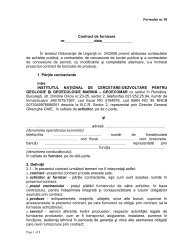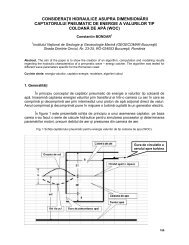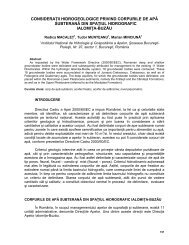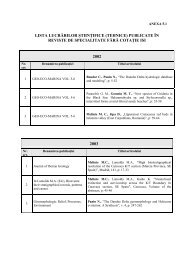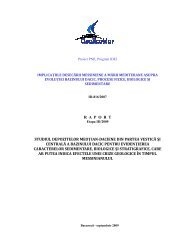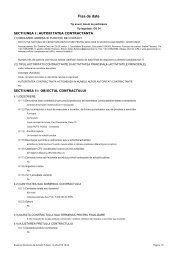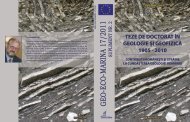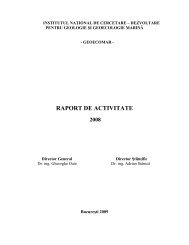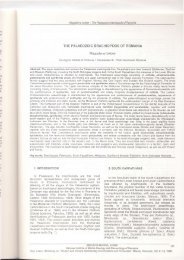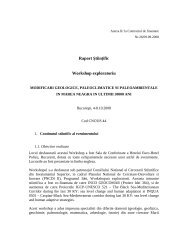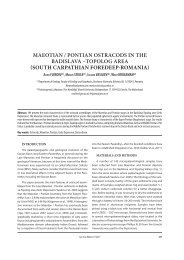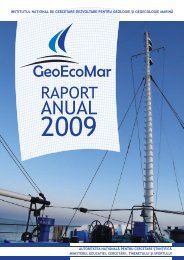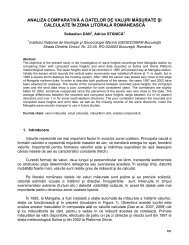DACIAN BASIN - GeoEcoMar
DACIAN BASIN - GeoEcoMar
DACIAN BASIN - GeoEcoMar
Create successful ePaper yourself
Turn your PDF publications into a flip-book with our unique Google optimized e-Paper software.
88<br />
Chapter 4. Dacian Basin Physiography<br />
4.3. <strong>DACIAN</strong> <strong>BASIN</strong> SEDIMENTATION DEPTH<br />
Estimation of the sedimentation depth in the Dacian Basin brackish-sea, have always<br />
been a subject of utmost importance for the Dacian Basin enthusiasts. The<br />
reduced possibility to compare data resulted from deposits on the margins and in<br />
the central part of the basin was – and still is – a factor limiting the understanding<br />
of the subject. We are going to approach the sedimentation depth problem with<br />
data coming from the two end zones of the Dacian Basin area.<br />
The northern end zone of the Dacian Basin is singled out by Saulea et al. (1969)<br />
as the area of the basin where extensive fresh-water or fresh-water influenced deposits<br />
have been observed (Fig. 4.5). A Late Sarmatian (s. l.) detrital-continental facies<br />
with mammal remains (Ichtiterium, Hipparion near the town of Iasi) is mentioned<br />
by Saulea et al. (1969). The brackish character (with Limnocardium) developed in<br />
the northernmost Dacian Basin area during the Early Pontian, but the continental<br />
facies appeared again during the Late Pontian.<br />
The shallow water characteristic of the deposits in the northern part of the Dacian<br />
Basin near Focşani is substantiated by the fluvial facies of the sediments. Sand<br />
beds, several meter thick and fining upward with erosional bottom features are intercalated<br />
in homogeneous (showing no bedding) silty clay, with rare fresh-water<br />
fossils. This aspect dominates the area at the west of Focşani, but southward of<br />
Buzău the homogeneous silty clay are progressively replaced by littoral brackish<br />
sand and clay sequences with wave ripples.<br />
A fine-grained sand and silt sequence with large scale inclined bedding (clinoforms)<br />
developed at the western margin of the Dacian Basin. The prograding facies<br />
was mentioned by Tărăpoancă (2004) and further investigated by Leveer (2007)<br />
(Fig. 4.6). The sequence is significant for the assessment of the sedimentation<br />
depth, as the thickness of the genetically unitary clinoform sequence indicates the<br />
minimal sediment accumulation water depth. On this base, a sedimentation depth<br />
of several hundred meters (around 300 m; Tărăpoancă, 2004; Leveer, 2007) can be<br />
appreciated for the Meotian-Pontian clinoform sedimentary succession.<br />
The evaluation of the sedimentation depth presented above suggests the image<br />
of a Dacian Basin brackish-marine trough which is fluvial to very shallow in<br />
the northern basin extremity, but shows a considerably deeper water depth at the<br />
opposite, western end (Fig. 4.7). The dominant longitudinal and southward flowing,<br />
paleocurrent trend, together with the sedimentation depth evaluated at the<br />
two extremities of the basin, are indications leading to the image of a Dacian Basin<br />
trough getting deeper and deeper from a fluvial environment in the north to a<br />
several meter depth marine setting in the western part.



